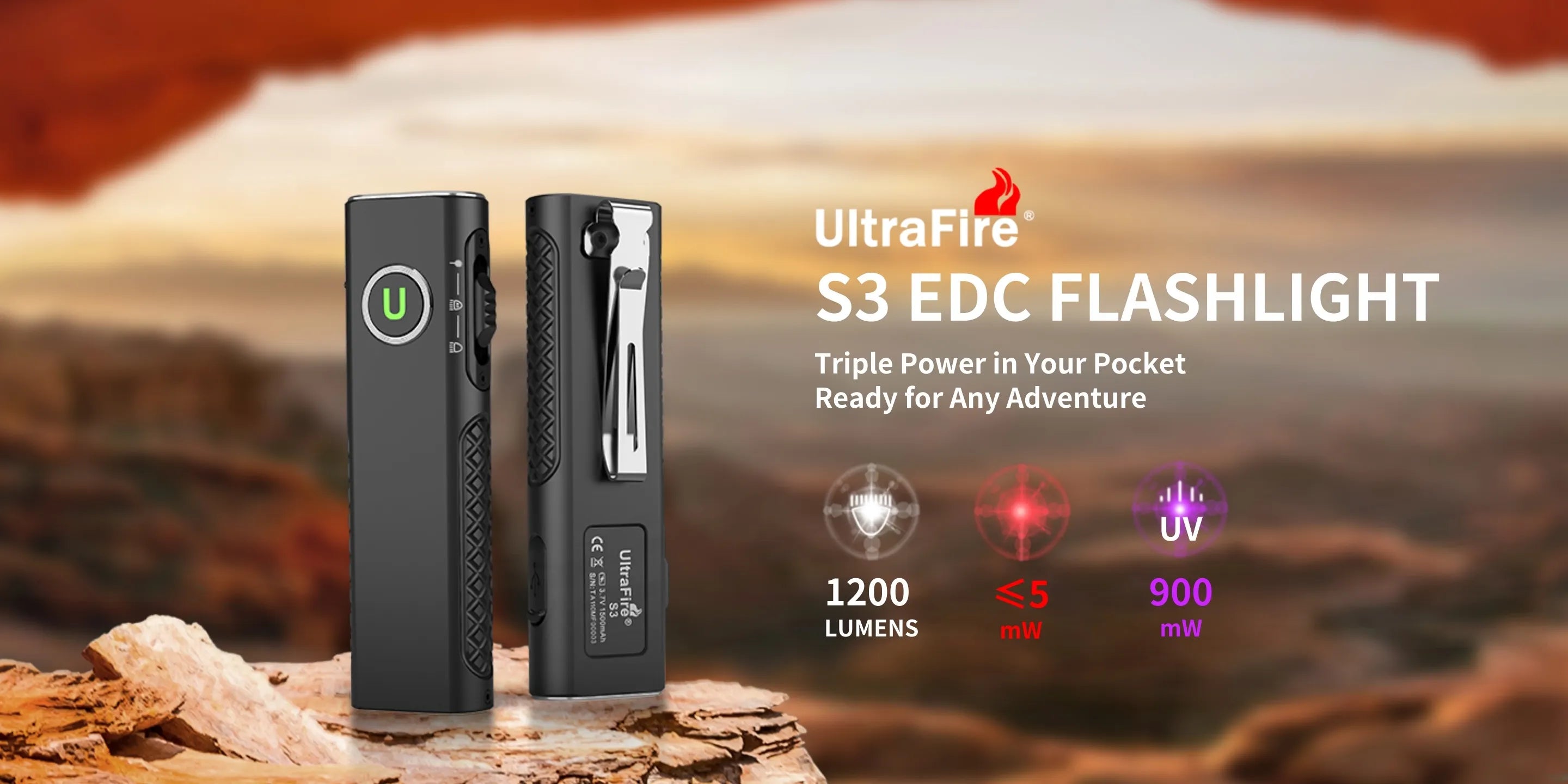1) Data & statistics — the numbers that actually matter
Below are the stable, practical metrics you’ll see on spec sheets and why they matter in the real world. Values are approximate ranges used by most manufacturers and testers.
-
Lumens (total output):
-
Low/utility EDC: 10–200 lm
-
Everyday carry / general-purpose: 100–1,200 lm
-
Tactical / search lamps: 1,200–4,000+ lm
Lumens tell you how much total visible light is emitted, but not how far it goes.
-
-
Candela & Beam Distance (throw):
-
Candela measures intensity in a given direction; beam distance in meters is derived from candela (roughly: distance ≈ √(candela) × constant depending on testing standard).
-
A lamp with high candela but moderate lumens will throw farther than a lamp with higher lumens but wide spill.
-
-
Runtime & usable runtime:
-
Runtime is usually given until the driver drops to a specified level (or until the battery is nearly empty).
-
Usable runtime (time you get practical light for the task) is what matters — thermal throttling and driver behavior often reduce peak runtime considerably.
-
Example: a 3,000 mAh 18650 cell powering 500 lm may last several hours on medium but only tens of minutes at turbo.
-
-
Battery chemistry & capacities (typical):
-
18650 Li-ion: ~2,500–3,500 mAh
-
21700 Li-ion: ~3,700–5,000 mAh
-
Built-in Li-Po: capacities vary widely (1,000–5,000 mAh), not user-replaceable.
-
Expect ~20–40% longer runtime moving from a well-matched 18650 to a comparable 21700, assuming driver efficiency is the same.
-
-
Charging & power delivery:
-
USB-C onboard charging is now common; charge currents of 1–2 A produce faster top-ups.
-
Charging speed vs battery longevity: faster charging is convenient, but frequent high-current charging can accelerate capacity loss over many cycles.
-
-
IP / ingress protection:
-
IPX4: splash resistant; IPX6: powerful water jets; IPX7 / IPX8: short/continuous immersion — choose based on intended environment.
-
2) Hands-on observations (synthesized from field reports and bench testing)
These are practical, repeatedly observed behaviors that separate good flashlights from forgettable ones.
-
UI beats raw specs in everyday use. A clean, predictable user interface (one-click on/off, direct-access low or high, lockout) saves time and prevents frustration. Fancy multi-mode sequences are impressive on paper but frustrating in the dark.
-
Thermal control wins for sustained tasks. A light that throttles smoothly and predictably is more useful than one that spikes to a high lumen number for a minute and then collapses. Look for documented thermal management or runtime curves if you rely on long searches.
-
Battery strategy matters. Swappable cell designs (18650/21700) give field resiliency — carry a spare cell. Built-in cells reduce bulk but create a single point of failure once capacity degrades.
-
Optics change perception. TIR optics give smooth, usable beams in compact lights but can reduce the effectiveness of specialty emitters (like UV) compared to open reflectors. For inspections (UV, forensic), optics and LED wavelength both matter.
-
Magnet & clip utility. A strong tail magnet and a solid two-way clip convert a flashlight into a hands-free tool instantly — valuable in repair, automotive, and fieldwork.
-
Self-discharge & firmware quirks. Some lights show unexpectedly high self-discharge when locked or in certain firmware states. If you need long storage, test your unit or check reports from other users.
3) Comparisons & rankings — by use case
Below are compact, practical rankings and what to prioritize for each role. Scoring criteria: Build / UI / Output / Runtime / Value.
A. Best EDC (everyday pocket carry) — prioritize size, UI, and balanced output
-
Slim single-cell EDC with USB-C — best balance for 95% of users.
-
Flat/multi-function EDC (UV/laser combos) — great if you need inspection/presentation tools, but watch battery and UI.
-
Tiny AAA/AA lights — super portable but limited output.
B. Best for outdoor search / long throw — prioritize candela & thermal design
-
Dedicated thrower (large reflector + 21700 or multiple cells) — top pick for distance.
-
Hybrid long-throw single-cell models — compromise between size and reach.
-
Flooders — good for campsite work but poor distance.
C. Best for inspections / forensic / hobbyist UV use — prioritize wavelength & optics
-
Open-face 365 nm UV lights — strongest fluorescence, best for verification.
-
TIR-mounted 365 nm combos — convenient but slightly weaker visible contrast.
-
395–400 nm “blacklight effect” lights — cheaper but less effective for true 365 nm fluorescence.
D. Best for professional/tactical use — prioritize reliability & predictable UI
-
Durable single-cell or multi-cell lights with proven UI and battery options — long runtime, field-replaceable cells.
-
Integrated battery lights with enterprise firmware — lower maintenance but less flexible.
4) Practical ranking checklist — how I score a lamp quickly
Score each criterion 1–5 and total; >20 = excellent for the intended use.
-
Build quality (materials, fit & finish)
-
UI & ergonomics (single-hand use, lockout, direct modes)
-
Output (usable sustained output, not just peak lumens)
-
Power & runtime (battery chemistry, swapability)
-
Extras (IP rating, magnet/clip, onboard charging)
-
Value (features vs price)
5) FAQ — concise, practical answers
Q: Lumens or candela — which should I trust?
A: Both. Use lumens to judge overall brightness and spill; use candela (or claimed throw distance) when you need reach. For most urban EDC tasks lumens matter more; for search and spotting, candela is king.
Q: How many lumens do I actually need for daily carry?
A: For walking the dog, finding keys, or household tasks, 100–300 lumens is usually sufficient. For signaling or brief outdoor search, 500–1,200 lumens is handy.
Q: Built-in battery vs replaceable cells — what should I choose?
A: If you want minimal size and don’t mind eventual replacement via service, built-in is fine. If you travel, work remotely, or need long-term reliability, pick swappable 18650/21700 designs. Carry a spare cell or a small power bank.
Q: My flashlight gets hot — is that normal?
A: Yes, high-output LEDs generate heat. Good lights manage heat via thermal regulation or heat sinks. Avoid prolonged use at turbo unless you accept throttling and thermal stress.
Q: Is UV light safe for general inspection?
A: Short bursts for inspection are commonly used, but avoid direct eye exposure and prolonged skin exposure. Prefer 365 nm emitters for real fluorescence checks; 395–400 nm near-UV shows less effect.
Q: How should I store spare lithium cells?
A: Store at ~40–60% charge in a cool, dry place. Avoid full charge or fully discharged states for long-term storage.
6) Quick field checklist
-
Test UI in daylight: confirm on/off, direct low/high, and lock.
-
Verify charge indicator behavior and approximate full charge time.
-
Do a short runtime test at your most-used brightness to estimate usable time.
-
Check magnet/clip strength if hands-free work matters.
-
If UV is a feature, test with known fluorescent material to confirm effectiveness.







